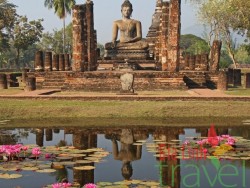Chiang Rai village
The North of ThaiLand


Mae Hong Son

Sukhothai
The fine weather, the mountainous scenery, the exquisite handicrafts and the rich northern Thai culture are some of the charms of the North.
The Northern Region of Thailand is rich in cultural heritage of the ancient Lanna Era and is made of Chiang Mai, Chiang Rai, Mae Hong Son, Phayao, Lampang, Lam phun, Phrae, Nan, Tak, Sukhothai, Utaradit, Phitsanulok, Kamphaeng Phet, Phichit, Phetchabun, Uthai Thani, and Nakhon Sawan provinces. The landscape is generally mountainous with cool weather during December to early February. During these months, the whole region is covered with beautiful flowers, attracting both Thai and International tourists. Before heading off, it is advisable to make hotel reservations in advance during the peak season. There is a diversity of interesting things to see and do around this region.
Nan (668 km from Bangkok) is where culture blends well with nature. This small and peaceful province amidst the mountains is one of the most exciting sites to shoot the rapids.
Chiang Mai (697 km), the second biggest province of Thailand, provides visitors with a host of places of interest, such as, Doi Suthep, Doi Inthanon, Bhubing Palace, etc. Also in Chiang Mai, there is a huge wood carving village called “Baan Tawai” where you can find the best deals for all sorts of wooden furniture and carvings of every kind. Towards the evening, the night Banzaar located in the heart of city comes alive as tourist shop of local handicrafts and antiques. Music lovers must visit the alfresco pubs that line the Mae Ping River where the live jazz is played late into the night.
Chiang Rai (785 km), located at the northern tip of Thailand in the very heart of the Golden Triangle, gains fame from its scenic views, exotic hill tribes and exciting elephant-back riding tours.
Lamphun (670 km) is a town of beautiful women, bountiful orchards and ancient temples. Lampang (599 km) is the sole province in Thailand where horse-drawn carriages are still used as a means of transportation. It is home to one of the largest elephant camps in the world. Western nature lovers often come here to learn the art of grooming and riding elephants, a profession that requires life long commitment for a Thai male since elephants grow every attached to their grooms and their lifespan is about the same as a human beings.. Phrae (643 km) is known for the northern costume called mohom and Phae Muang Phi, a small area of weird earth formation.
Lying in the northwestern corner bordering Myanmar, Mae Hong Son (942 km) is well known as the “Town of Three Mists” because it is mist-shrouded throughout most of the three seasons. It has several tourist attractions, both natural and cultural. Being mountainous, the province has many waterfalls and caves.
Sukhothai Province (427 km), the first truly independent Thai Kingdom, was formed in the 13th century. It was an era of great cultural achievements. Rich in historical background, The Sukhothai Historical Park is considered a UNESCO world heritage site. Among other great cultural achievements, the Thai alphabet was formed during the reign of King Ramkhamhaeng. Numerous magnificent temples and intimidating Chedis (pagodas) can still be seen throughout the province.
Tak (426 km) – this mountainous province is ideal for nature lovers and adventurous tourists as there are numerous places for white-water rafting, trekking and elephant riding. Blessed with high mountains and natural beauty, Phetchabun (346 km) is where the scenic Nam Nao National Park and Phu Hin Rong Kla National Park are situated. It is also rich with waterfalls, rivers and lakes.
Phisanulok (377), also an important province in Thai history, declared its independence from Burma in 1584 under the reign of King Naresuan – It was this great king that united the Kingdom of Siam, known as Thailand today.
